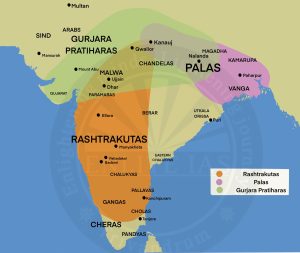Rashtrakuta Dynasty (753 – 982 CE)
- The Rashtrakuta Empire ruled over the Deccan for over 200 years, until the end of the 10th century. At different times, it also held territories in north and south India.
Important Rulers
- Dantidurga- The Rashtrakuta empire was founded by Dantidurga, who established his capital at Manyakheta or Malkhed, close to present-day Sholapur.
- He appears to be Karka II’s contemporary.
- After attacking the Pallava capital of Kanchi, Dantidurga forged a partnership with Nandivarman Pallavamalla.
- In 753 CE, Dantidurga took control of the periphery of the vast Chalukyan empire. Subsequently, he launched an attack on the empire’s core, decisively defeating Kirtivarman.
- According to the Samangadh inscription from 754 CE, Dantidurga deposed Kirtivarman II, the last Chalukya king of Badami, and took full imperial position. He also identified himself as Prithivivallabha, Maharajadhiraja, Parameshvara, and Parama Bhattaraka
- Krishnaraja I – Krishnaraja I was successful in gaining the throne in 756 CE due to his popularity.
- In the Bhandak Inscription, he was referred to as Shubh Tunga (high in prosperity) and Akalavarsha (continuous rainer).
- Under his leadership, the newly founded Rashtrakuta kingdom grew in all directions.
- He began with overthrowing the Chalukyas of Badami.
- Govinda II – Took titles Prabhutavarsha (profuse rainer) and Vikramavaloka (the man with a heroic look).
- Amoghavarsha I – Amoghavarsha I (814–878 CE) established himself as one of the greatest Rashtrakuta kings.
- He was called Nripatunga (exalted among kings), Atisayadhavala (wonderfully white in conduct), Maharaja-shanda (best of the great kings), and Vira-Narayana (the heroic Narayana).
- His inscriptions list him among the most well-known adherents of Jainism. He was an author as well as a patron of writers.
- The author of Adipurana, Jinasena, was one of Amoghavarsha I’s Jaina preceptors.
- He not only preached Jainism but also the Brahmanical faith, and he performed various rites for the benefit of his citizens.
- Krishna III- Krishna III conquered Chola ruler Parantaka I (949 CE), capturing the Chola empire’s northern region.
- He then descended to Rameshwaram, where he erected a triumph pillar and established a temple.
Administration
- Rashtrakuta’s administration was monarchical.
- The king was responsible for the maintenance of law and order in the kingdom.
- The king’s position was largely hereditary, but the succession laws were not stringent.
- The eldest son frequently succeeded, but there were numerous occasions when he had to fight and sometimes lost to his younger brothers.
- The Rashtrakuta kingdom’s directly controlled territories were divided into:
- Rashtra (Province)
- Vishaya
- Bhukti
- The kosha-pala or kotwal was responsible for maintaining law and order in the cities and areas surrounding them.
- The Rashtrakuta rulers had massive and well-organized infantry, cavalry, and a considerable number of war elephants, as described in the chronicles of Arab travelers.

Economy
- The Rashtrakuta Empire’s economy was fueled by agricultural and natural produce, money earned through territorial subjugation, and revenues from manufacturing businesses. Cotton was the main crop in the Rashtrakuta districts of southern Gujarat, including Khandesh and Berar.
- Ujjain, Paithan, and Tagara were important textile manufacturing hubs. Muslin textile was woven at Paithan and Warangal. Cotton yarn and fabric were shipped from the port of Bharuch. The Deccan soil, while not as fruitful as the Gangetic plains, was rich in mineral resources.
- Cuddapah, Bellary, Ahmednagar, Bijapur, and Dharwar copper mines were a significant source of wealth and contributed significantly to the local economy.
- The leather and tanning business thrived in Gujarat as well as in other areas of northern Maharashtra.
Literature
- The Kavirajamarga was published during the reign of Amoghavarsha I.
- Adikavi Pampa, recognized as one of the best Kannada writers, became well-known for Adipurana under the Rashtrakuta dynasty.
- The inscriptions from the Rashtrakuta era were rich in literary content.
Art and Architecture
- Ellora and Elephanta include the finest specimens of Rashtrakuta art and architecture. Ellora’s most notable feature is the Kailasa temple. The excavation took place during the reign of Rashtrakuta King Krishna-I. It is carved as a three-story temple excavated from the top down in a monolithic way.
- The Kailasa temple is regarded as an architectural marvel due to its exquisite statues. The Kailasa temple has a Dravidian architectural style.
- The Rashtrakutas’ sculptural art peaked in the Elephanta islands near Mumbai. The sculptures of Ellora and Elephanta are closely linked.
- Lifelike dwara-palaka figurines can be found at the entrance to the sanctum sanctorum. Shiva images are carved in various shapes on the walls of the prakara surrounding the shrine, including Nataraja, Gangadhara, Ardhanareeswara, and Somaskanda.
Decline
- The Rashtrakutas’ decline began with the reign of Khottiga Amoghavarsha, who was defeated and assassinated by a Paramara dynasty monarch in 972 CE, with the capital Manyakheta sacked and destroyed, severely damaging the dynasty’s reputation.
